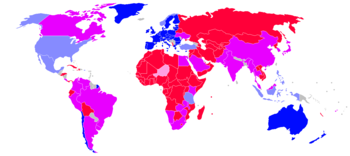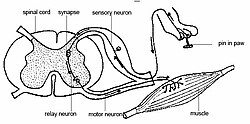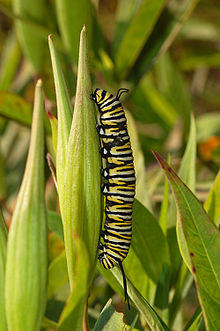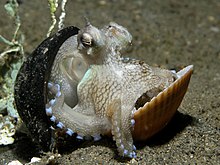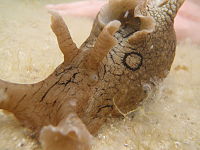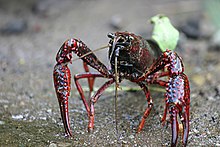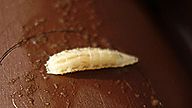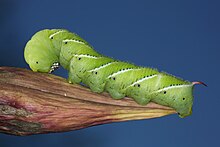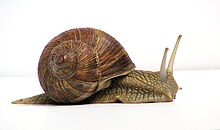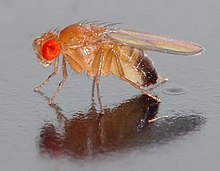A Galapagos shark hooked by a fishing boat
| | National recognition of animal sentience | | Partial recognition of animal sentience1 |
| | National recognition of animal suffering | | Partial recognition of animal suffering2 |
| | No recognition of animal sentience or suffering | | Unknown |
1certain animals are excluded, only mental health is acknowledged, and/or the laws vary internally
2only includes domestic animals
2only includes domestic animals
Pain negatively affects the health and welfare of animals. "Pain" is defined by the International Association for the Study of Pain as "an unpleasant sensory and emotional experience associated with actual or potential tissue damage, or described in terms of such damage."
Only the person experiencing the pain can know the pain's quality and
intensity, and the degree of suffering. However, for non-human animals,
it is harder, if even possible, to know whether an emotional experience
has occurred. Therefore, this concept is often excluded in definitions of pain in animals, such as that provided by Zimmerman:
"an aversive sensory experience caused by actual or potential injury
that elicits protective motor and vegetative reactions, results in
learned avoidance and may modify species-specific behaviour, including
social behaviour."
Non-human animals cannot report their feelings to language-using humans
in the same manner as human communication, but observation of their
behaviour provides a reasonable indication as to the extent of their
pain. Just as with doctors and medics who sometimes share no common
language with their patients, the indicators of pain can still be
understood.
According to the U.S. National Research Council Committee on
Recognition and Alleviation of Pain in Laboratory Animals, pain is
experienced by many animal species, including mammals and possibly all vertebrates.
The experience of pain
Although there are numerous definitions of pain, almost all involve two key components. First, nociception is required. This is the ability to detect noxious stimuli which evoke a reflex
response that rapidly moves the entire animal, or the affected part of
its body, away from the source of the stimulus. The concept of
nociception does not imply any adverse, subjective "feeling" – it is a
reflex action. An example in humans would be the rapid withdrawal of a
finger that has touched something hot – the withdrawal occurs before any
sensation of pain is actually experienced.
The second component is the experience of "pain" itself, or suffering
– the internal, emotional interpretation of the nociceptive experience.
Again in humans, this is when the withdrawn finger begins to hurt,
moments after the withdrawal. Pain is therefore a private, emotional
experience. Pain cannot be directly measured in other animals, including
other humans; responses to putatively painful stimuli can be measured,
but not the experience itself. To address this problem when assessing
the capacity of other species to experience pain, argument-by-analogy is
used. This is based on the principle that if an animal responds to a
stimulus in a similar way to ourselves, it is likely to have had an
analogous experience.
Reflex response to painful stimuli
Reflex
arc of a dog when its paw is stuck with a pin. The spinal cord responds
to signals from receptors in the paw, producing a reflex withdrawal of
the paw. This localized response does not involve brain processes that
might mediate a consciousness of pain, though these might also occur.
Nociception usually involves the transmission of a signal along nerve fibers
from the site of a noxious stimulus at the periphery to the spinal
cord. Although this signal is also transmitted on to the brain, a reflex response, such as flinching or withdrawal of a limb, is produced by return signals originating in the spinal cord. Thus, both physiological
and behavioral responses to nociception can be detected, and no
reference need be made to a conscious experience of pain. Based on such
criteria, nociception has been observed in all major animal taxa.
Awareness of pain
Nerve
impulses from nociceptors may reach the brain, where information about
the stimulus (e.g. quality, location, and intensity), and affect
(unpleasantness) are registered. Though the brain activity involved has
been studied, the brain processes underlying conscious awareness are not
well known.
Adaptive value
The adaptive value
of nociception is obvious; an organism detecting a noxious stimulus
immediately withdraws the limb, appendage or entire body from the
noxious stimulus and thereby avoids further (potential) injury. However,
a characteristic of pain (in mammals at least) is that pain can result
in hyperalgesia (a heightened sensitivity to noxious stimuli) and allodynia
(a heightened sensitivity to non-noxious stimuli). When this heightened
sensitisation occurs, the adaptive value is less clear. First, the pain
arising from the heightened sensitisation can be disproportionate to
the actual tissue damage caused. Second, the heightened sensitisation
may also become chronic, persisting well beyond the tissues healing.
This can mean that rather than the actual tissue damage causing pain, it
is the pain due to the heightened sensitisation that becomes the
concern. This means the sensitisation process is sometimes termed maladaptive.
It is often suggested hyperalgesia and allodynia assist organisms to
protect themselves during healing, but experimental evidence to support
this has been lacking.
In 2014, the adaptive value of sensitisation due to injury was tested using the predatory interactions between longfin inshore squid (Doryteuthis pealeii) and black sea bass (Centropristis striata)
which are natural predators of this squid. If injured squid are
targeted by a bass, they began their defensive behaviours sooner
(indicated by greater alert distances and longer flight initiation
distances) than uninjured squid. If anaesthetic (1% ethanol and MgCl2)
is administered prior to the injury, this prevents the sensitisation
and blocks the behavioural effect. The authors claim this study is the
first experimental evidence to support the argument that nociceptive
sensitisation is actually an adaptive response to injuries.
Argument-by-analogy
To assess the capacity of other species to consciously suffer pain we resort to argument-by-analogy.
That is, if an animal responds to a stimulus the way a human does, it
is likely to have had an analogous experience. If we stick a pin in a
chimpanzee's finger and she rapidly withdraws her hand, we use
argument-by-analogy and infer that like us, she felt pain. It might be
argued that consistency requires us infer, also, that a cockroach
experiences conscious pain when it writhes after being stuck with a pin.
The usual counter-argument is that although the physiology of
consciousness is not understood, it clearly involves complex brain
processes not present in relatively simple organisms. Other analogies have been pointed out. For example, when given a choice of foods, rats and chickens
with clinical symptoms of pain will consume more of an
analgesic-containing food than animals not in pain. Additionally, the
consumption of the analgesic carprofen in lame chickens was positively correlated to the severity of lameness, and consumption resulted in an improved gait. Such anthropomorphic
arguments face the criticism that physical reactions indicating pain
may be neither the cause nor result of conscious states, and the
approach is subject to criticism of anthropomorphic interpretation. For
example, a single-celled organism such as an amoeba may writhe after
being exposed to noxious stimuli despite the absence of nociception.
History
The idea that animals might not experience pain or suffering as humans do traces back at least to the 17th-century French philosopher, René Descartes, who argued that animals lack consciousness.
Researchers remained unsure into the 1980s as to whether animals
experience pain, and veterinarians trained in the U.S. before 1989 were
simply taught to ignore animal pain. In his interactions with scientists and other veterinarians, Bernard Rollin
was regularly asked to "prove" that animals are conscious, and to
provide "scientifically acceptable" grounds for claiming that they feel
pain. Some authors say that the view that animals feel pain differently is now a minority view.
Academic reviews of the topic are more equivocal, noting that, although
it is likely that some animals have at least simple conscious thoughts
and feelings, some authors continue to question how reliably animal mental states can be determined.
In different species
The
ability to experience pain in an animal, or another human for that
matter, cannot be determined directly but it may be inferred through
analogous physiological and behavioral reactions.
Although many animals share similar mechanisms of pain detection to
those of humans, have similar areas of the brain involved in processing
pain, and show similar pain behaviours, it is notoriously difficult to
assess how animals actually experience pain.
Nociception
Nociceptive
nerves, which preferentially detect (potential) injury-causing stimuli,
have been identified in a variety of animals, including invertebrates.
The medicinal leech, Hirudo medicinalis, and sea slug are classic model systems for studying nociception. Many other vertebrate and invertebrate animals also show nociceptive reflex responses similar to our own.
Pain
Many animals
also exhibit more complex behavioural and physiological changes
indicative of the ability to experience pain: they eat less food, their
normal behaviour is disrupted, their social behaviour is suppressed,
they may adopt unusual behaviour patterns, they may emit characteristic
distress calls, experience respiratory and cardiovascular changes, as
well as inflammation and release of stress hormones.
Some criteria that may indicate the potential of another species to feel pain include:
- Has a suitable nervous system and sensory receptors
- Physiological changes to noxious stimuli
- Displays protective motor reactions that might include reduced use of an affected area such as limping, rubbing, holding or autotomy
- Has opioid receptors and shows reduced responses to noxious stimuli when given analgesics and local anaesthetics
- Shows trade-offs between stimulus avoidance and other motivational requirements
- Shows avoidance learning
- High cognitive ability and sentience
Vertebrates
Fish
A typical human cutaneous nerve contains 83% C type trauma receptors (the type responsible for transmitting signals described by humans as excruciating pain); the same nerves in humans with congenital insensitivity to pain have only 24-28% C type receptors. The rainbow trout has about 5% C type fibres, while sharks and rays have 0%.
Nevertheless, fish have been shown to have sensory neurons that are
sensitive to damaging stimuli and are physiologically identical to human
nociceptors.
Behavioural and physiological responses to a painful event appear
comparable to those seen in amphibians, birds, and mammals, and
administration of an analgesic drug reduces these responses in fish.
Animal welfare advocates have raised concerns about the possible
suffering of fish caused by angling. Some countries, e.g. Germany, have
banned specific types of fishing, and the British RSPCA now formally prosecutes individuals who are cruel to fish.
Invertebrates
Though it has been argued that most invertebrates do not feel pain, there is some evidence that invertebrates, especially the decapod crustaceans (e.g. crabs and lobsters) and cephalopods (e.g. octopuses), exhibit behavioural and physiological reactions indicating they may have the capacity for this experience.
Nociceptors have been found in nematodes, annelids and molluscs. Most insects do not possess nociceptors, one known exception being the fruit fly. In vertebrates, endogenous opioids
are neurochemicals that moderate pain by interacting with opiate
receptors. Opioid peptides and opiate receptors occur naturally in
nematodes, molluscs, insects and crustaceans.
The presence of opioids in crustaceans has been interpreted as an
indication that lobsters may be able to experience pain, although it has
been claimed "at present no certain conclusion can be drawn".
One suggested reason for rejecting a pain experience in
invertebrates is that invertebrate brains are too small. However, brain
size does not necessarily equate to complexity of function. Moreover, weight for body-weight, the cephalopod
brain is in the same size bracket as the vertebrate brain, smaller than
that of birds and mammals, but as big as or bigger than most fish
brains.
Since September 2010, all cephalopods being used for scientific
purposes in the EU are protected by EU Directive 2010/63/EU which states
"...there is scientific evidence of their [cephalopods] ability to
experience pain, suffering, distress and lasting harm. In the UK, animal protection legislation
means that cephalopods used for scientific purposes must be killed
humanely, according to prescribed methods (known as "Schedule 1 methods
of euthanasia") known to minimise suffering.
In medicine and research
Veterinary medicine
Veterinary medicine uses, for actual or potential animal pain, the same analgesics and anesthetics as used in humans.
Dolorimetry
Dolorimetry (dolor:
Latin: pain, grief) is the measurement of the pain response in animals,
including humans. It is practiced occasionally in medicine, as a
diagnostic tool, and is regularly used in research into the basic
science of pain, and in testing the efficacy of analgesics. Non-human
animal pain measurement techniques include the paw pressure test, tail flick test, hot plate test and grimace scales.
Laboratory animals
Animals are kept in laboratories for a wide range of reasons, some of
which may involve pain, suffering or distress, whilst others (e.g. many
of those involved in breeding) will not. The extent to which animal testing causes pain and suffering in laboratory animals is the subject of much debate. Marian Stamp Dawkins
defines "suffering" in laboratory animals as the experience of one of
"a wide range of extremely unpleasant subjective (mental) states." The U.S. National Research Council has published guidelines on the care and use of laboratory animals, as well as a report on recognizing and alleviating pain in vertebrates. The United States Department of Agriculture
defines a "painful procedure" in an animal study as one that would
"reasonably be expected to cause more than slight or momentary pain or
distress in a human being to which that procedure was applied." Some critics argue that, paradoxically, researchers raised in the era of increased awareness of animal welfare may be inclined to deny that animals are in pain simply because they do not want to see themselves as people who inflict it. PETA however argues that there is no doubt about animals in laboratories being inflicted with pain. In the UK, animal research likely to cause "pain, suffering, distress or lasting harm" is regulated by the Animals (Scientific Procedures) Act 1986 and research with the potential to cause pain is regulated by the Animal Welfare Act of 1966 in the US.
In the U.S., researchers are not required to provide laboratory
animals with pain relief if the administration of such drugs would
interfere with their experiment. Laboratory animal veterinarian Larry
Carbone writes, "Without question, present public policy allows humans
to cause laboratory animals unalleviated pain. The AWA, the Guide for the Care and Use of Laboratory Animals,
and current Public Health Service policy all allow for the conduct of
what are often called "Category E" studies – experiments in which
animals are expected to undergo significant pain or distress that will
be left untreated because treatments for pain would be expected to
interfere with the experiment."
Severity scales
Eleven
countries have national classification systems of pain and suffering
experienced by animals used in research: Australia, Canada, Finland,
Germany, The Republic of Ireland, The Netherlands, New Zealand, Poland,
Sweden, Switzerland, and the UK. The US also has a mandated national
scientific animal-use classification system, but it is markedly
different from other countries in that it reports on whether
pain-relieving drugs were required and/or used.
The first severity scales were implemented in 1986 by Finland and the
UK. The number of severity categories ranges between 3 (Sweden and
Finland) and 9 (Australia). In the UK, research projects are classified
as "mild", "moderate", and "substantial" in terms of the suffering the
researchers conducting the study say they may cause; a fourth category
of "unclassified" means the animal was anesthetized and killed without
recovering consciousness. It should be remembered that in the UK system,
many research projects (e.g. transgenic breeding, feeding distasteful
food) will require a license under the Animals (Scientific Procedures) Act 1986,
but may cause little or no pain or suffering. In December 2001, 39
percent (1,296) of project licenses in force were classified as "mild",
55 percent (1,811) as "moderate", two percent (63) as "substantial", and
4 percent (139) as "unclassified".
In 2009, of the project licenses issued, 35 percent (187) were
classified as "mild", 61 percent (330) as "moderate", 2 percent (13) as
"severe" and 2 percent (11) as unclassified.
In the US, the Guide for the Care and Use of Laboratory Animals
defines the parameters for animal testing regulations. It states, "The
ability to experience and respond to pain is widespread in the animal
kingdom...Pain is a stressor and, if not relieved, can lead to
unacceptable levels of stress and distress in animals. " The Guide
states that the ability to recognize the symptoms of pain in different
species is essential for the people caring for and using animals.
Accordingly, all issues of animal pain and distress, and their potential
treatment with analgesia and anesthesia, are required regulatory issues
for animal protocol approval.

